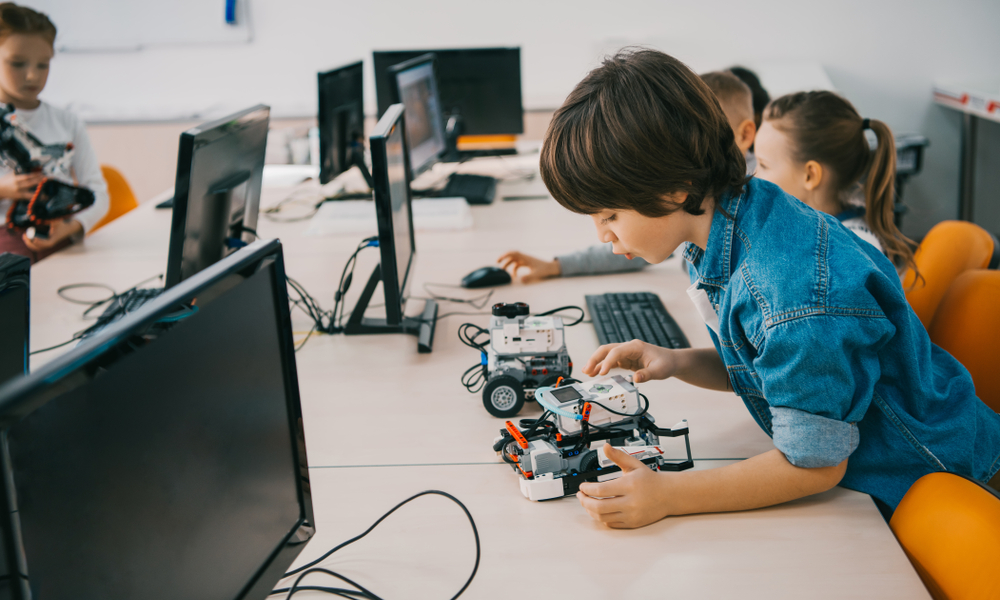In today’s fast-paced and technology-driven world, STEM education (Science, Technology, Engineering, and Mathematics) plays a crucial role in preparing students for future careers, critical thinking, and problem-solving. STEM education goes beyond traditional classroom learning, encouraging hands-on exploration, creativity, and real-world applications that equip students with the skills they need to succeed in an increasingly digital and innovation-focused society.
By fostering curiosity and innovation, STEM programs inspire students to become future leaders, engineers, scientists, and problem solvers who can tackle global challenges and drive progress.
Why STEM Education Matters
STEM education bridges the gap between academics and real-world application, helping students develop skills that are essential for success in the 21st century. Whether it’s coding, robotics, environmental science, or physics, STEM subjects enhance logical reasoning, collaboration, and analytical thinking—qualities that are highly sought after in today’s workforce.
Key Benefits of STEM Education
✔ Encourages Critical Thinking & Problem-Solving – Helps students analyze, evaluate, and find creative solutions to complex issues.
✔ Prepares Students for High-Demand Careers – STEM-related fields offer lucrative job opportunities in industries such as technology, engineering, healthcare, and environmental science.
✔ Fosters Creativity & Innovation – STEM education encourages experimentation and thinking outside the box.
✔ Enhances Collaboration & Teamwork – Many STEM projects involve group-based learning, improving students’ ability to work with others.
✔ Builds Digital & Technical Literacy – As technology continues to evolve, STEM subjects equip students with essential digital skills.
STEM education is not just about learning theories—it’s about applying knowledge to solve real-world challenges.
The Core Components of STEM Learning
A well-rounded STEM education focuses on four key areas, integrating them into dynamic, hands-on learning experiences.
1. Science: Exploring the World Through Inquiry
Science education develops curiosity, experimentation, and evidence-based reasoning. Students engage in:
✔ Hands-on experiments and lab work
✔ Understanding biological, chemical, and physical processes
✔ Learning about sustainability, space exploration, and environmental conservation
Through scientific exploration, students learn how the world works and develop skills to innovate solutions for real-life problems.
2. Technology: Embracing the Digital Age
Technology is evolving at an unprecedented rate, and digital literacy is now a fundamental skill. STEM programs integrate:
✔ Computer programming and coding
✔ Artificial Intelligence (AI) and data science
✔ Cybersecurity and ethical digital use
By mastering technology, students gain a competitive edge in the job market and become active contributors to the tech-driven world.
3. Engineering: Designing and Building the Future
Engineering education combines creativity with technical skills, allowing students to build, invent, and innovate. It includes:
✔ Robotics and automation projects
✔ Structural and mechanical design challenges
✔ Environmental and sustainable engineering solutions
Through engineering, students develop problem-solving skills and a deep understanding of how things work.
4. Mathematics: The Foundation of Logical Thinking
Mathematics is the backbone of STEM, providing the tools for analyzing data, solving equations, and making informed decisions. STEM learning incorporates:
✔ Advanced problem-solving techniques
✔ Data interpretation and statistical analysis
✔ Mathematical modeling for real-world applications
With a strong foundation in math, students develop logical reasoning and computational thinking skills that are applicable in all aspects of life.
Who Benefits from STEM Education?
STEM education is suitable for students of all ages and backgrounds. It is particularly beneficial for:
✔ Students with a passion for discovery and innovation – Encourages exploration in science, coding, robotics, and engineering.
✔ Young learners who enjoy hands-on projects – Ideal for students who thrive in interactive and project-based learning.
✔ Individuals interested in future careers in technology, medicine, and engineering – Helps build a strong academic foundation for STEM-related fields.
✔ Children who love problem-solving and logic-based activities – Enhances critical thinking and analytical skills.
✔ Parents who want to equip their children with future-ready skills – Ensures students are prepared for the digital and technological landscape.
STEM education nurtures curiosity, resilience, and lifelong learning, making it ideal for every student who wants to succeed in the modern world.
The Future of STEM Careers
STEM fields are among the fastest-growing and highest-paying industries worldwide. Careers in technology, healthcare, engineering, and data science are in high demand, and STEM education lays the foundation for success in these areas.
Some of the most in-demand STEM careers include:
✔ Software Engineers & Programmers – Designing and developing applications, websites, and AI systems.
✔ Biomedical Engineers – Creating medical innovations to improve healthcare.
✔ Data Scientists & Analysts – Interpreting complex data for business and research solutions.
✔ Environmental Scientists – Finding sustainable solutions for climate change and conservation.
✔ Mechanical & Civil Engineers – Designing buildings, infrastructure, and new technology.
By pursuing STEM education, students gain access to exciting and high-paying career opportunities that are shaping the future.
How to Incorporate STEM Learning at Home
STEM education doesn’t have to be limited to the classroom. Parents can encourage STEM learning at home with fun, interactive activities such as:
✔ Building simple machines or robotics kits
✔ Encouraging coding with beginner-friendly programs like Scratch or Python
✔ Conducting home science experiments using everyday materials
✔ Playing logic-based games and puzzles
✔ Introducing hands-on math challenges and real-world problem-solving
With engaging and interactive experiences, students can develop a love for STEM subjects at an early age.
Transform the Future with STEM Education
STEM education is more than just a curriculum—it’s a mindset that fosters creativity, innovation, and problem-solving. By integrating science, technology, engineering, and math into learning, students develop critical thinking skills and gain the tools needed to excel in the modern world.
Whether your child is interested in robotics, coding, environmental science, or mathematical problem-solving, STEM education opens doors to limitless possibilities.
Prepare your child for a future of innovation and discovery! Explore STEM programs and hands-on learning opportunities to give them a strong foundation for success.
Get started today—because the future belongs to those who innovate!





